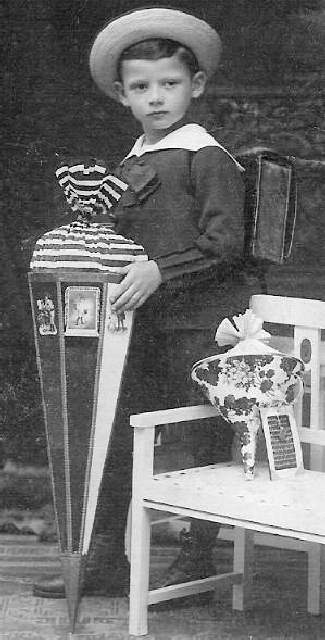
Figure 1.--The brims on sailor hats varied in width. This Dresden boy beginning school around 1910 wears a sailor hat with a modestly sized brim. Note the vard on the smaller Zucertuten with a card made to look like the boy's school slate. |

|
The most destinctive feature of a sailor hat was the brim. This was especially the case for a wide-brimmed hat. We note sailor hats done with varying brim widths. The most striking ones were the wide-brimmed hsats. Smsaller boys seem most lost in them. There were also sailor hats with both small and medium brims. The straw hats we see first in the 19th century are more like boaters with fairly narrow brims. Wide-brimmed hats became quite popular by the 1890s. At first we see more of these hats than sailor caps. Wide-brimmed sailor hats were especially popular for younger boys. Several images of German boys wearing broad-brimmed sailor hats are atrchived on HBC. A good example is an unidentified German boy. Sailor hats were normally worn with brims turned up. A fashion of turning down the brim became popular in the 1910s. Wide brimmed hats seem today rather a decorative rather than a practical headwear style. There was, however, a practical aspect to them. Light complexions were considered more attractive at the time. Thus for children a wide-brimmed sailor hat was a kind of early sun-safe garment.
The most destinctive feature of a sailor hat was the brim. This was especially the case for a wide-brimmed hat. We note sailor hats done with varying brim widths. The most striking ones were the wide-brimmed hats. Smaller boys seem most lost in them. Wide-brimmed hats became quite popular by the 1890s. At first we see more of these hats than sailor caps. Wide-brimmed sailor hats were especially popular for younger boys. Several images of German boys wearing broad-brimmed sailor hats are atrchived on HBC. A good example is an unidentified German boy. Sailor hats were normally worn with brims turned up. A fashion of turning down the brim became popular in the 1910s. Wide brimmed hats seem today rather a decorative rather than a practical headwear style. There was, however, a practical aspect to them. Light complexions were considered more attractive at the time. Thus for children a wide-brimmed sailor hat was a kind of early sun-safe garment. We continue to see wide-brimmed sailor hats in the 1900s, but in the 1910s they begin to decline in popularity, especially after the start of World War (1914). Wide-nrimed sailor caps wwereworn by pre-school boys and younger primary school boys. Girls also wore them. but the largest seems to be more common wiyh boys. We also seem to detect a social-class factor. They seem most common with boys from affluent families. Wide-berimmed sailor hats were almost always straw chats.
There were also sailor hats with medium brims. We notice simewhat older biys wearing the sailor hats wuth medium brims.
The straw hats we see first in the 19th century are more like boaters with fairly narrow brims.
Navigate the Boys' Historical Clothing German pages:
[Return to the Main sailor hat brim page]
[Return to the Main Gernman sailor hat page]
[Return to the Main German sailor headwear page]
[German choirs]
[German scouts]
[Hitler Youth]
[German school uniforms]
[German royalty]
[German sailor suits]
[Lederhosen]
[Ethnic]
[Tights]
[Long stockings]
Navigate the Boys' Historical Clothing Web Site:
[Introduction]
[Activities]
[Biographies]
[Chronology]
[Clothing styles]
[Countries]
[Bibliographies]
[Contributions]
[FAQs]
[German glossary]
[Images]
[Links]
[Registration]
[Tools]
[Boys' Clothing Home]
